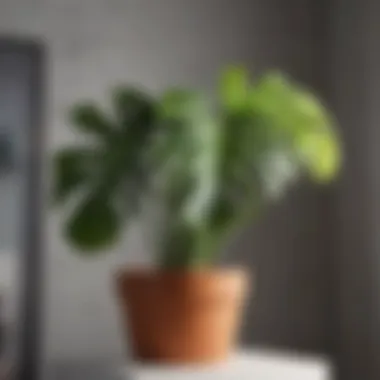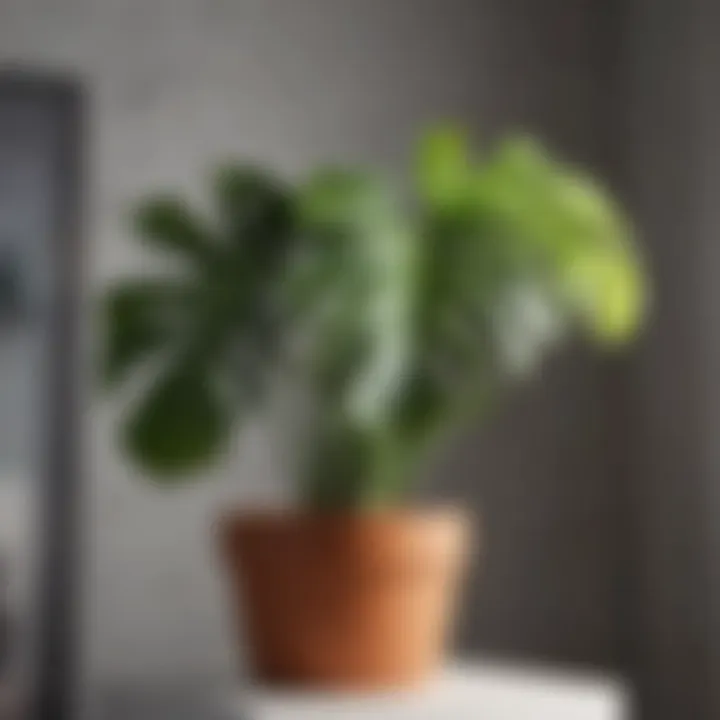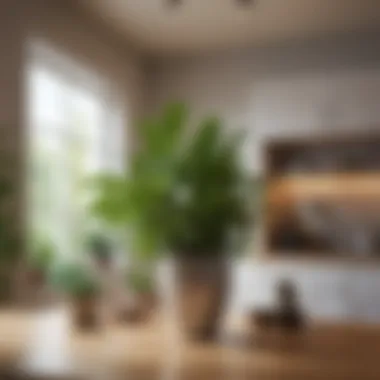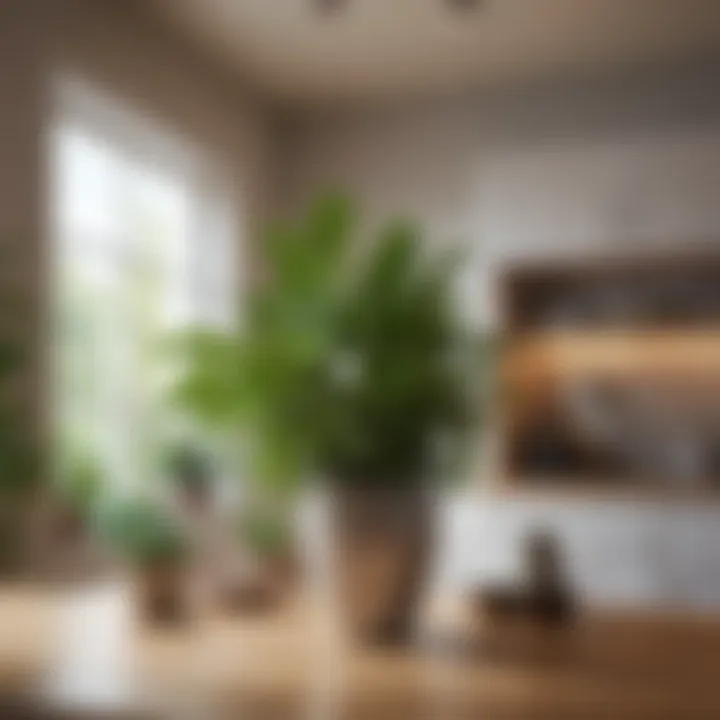Incorporating Big Plants Into Home Spaces Effectively


Intro
Integrating large plants into home spaces is not merely a trend; it represents a shift in how we perceive and utilize our indoor environments. Houseplants, particularly larger specimens, have the capacity to enhance aesthetics while contributing positively to our mental well-being. This guide will provide a comprehensive approach to selecting, arranging, and maintaining big plants, transforming your living space into a vibrant sanctuary.
The focus here will include practical advice on plant species that thrive indoors, insights into their benefits, and effective strategies for incorporating them into your home design. Whether you are an avid gardener or a beginner, there is a wealth of knowledge to gain in creating your ideal indoor ecosystem.
Design Inspiration
Current Trends in Interior Design
The recent design trends emphasize minimalistic yet natural spaces. The idea is to blur the lines between indoor and outdoor living. Large plants can play a pivotal role in this approach, providing depth and texture to a room. Palms, fiddle leaf figs, and monstera plants are becoming prominent features in many homes.
Incorporating big plants aligns well with the concepts of biophilic design, which aims to connect occupants more closely with nature. As people increasingly seek havens from urban life, these plants can serve as living art pieces that bring life and freshness into your home.
"Biophilic design is more than aesthetics; it's a necessity for our well-being."
Color Schemes and Palette Ideas
When integrating large plants, colour coordination is crucial. Selecting pots that complement your existing decor can create a cohesive look. Consider neutral tones like terracotta or matte blacks that can enhance the greenery. These are versatile and can match various colour palettes.
Additionally, it is essential to consider the colour of the walls and furniture. For instance:
- Light walls allow dark green leaves to pop.
- Dark walls can create a dramatic backdrop for lighter, more vibrant foliage.
These combinations can help to create a balanced atmosphere, inviting warmth and comfort into your spaces.
Gardening Techniques
Plant Selection and Care
Choosing the right plant species is vital. Some large plants such as rubber plants, snake plants, and peace lilies not only grow well indoors but also require minimal care, making them ideal for many homeowners. When selecting a species, consider the available light in your home, as well as humidity levels.
Providing adequate care includes:
- Regular watering, ensuring not to overwater.
- Fertilization during the growing season.
- Pruning to promote healthy growth.
Understanding these requirements will contribute to a thriving plant, enhancing your environment.
Indoor vs. Outdoor Gardening
While indoor plants offer certain advantages, there are scenarios when exterior gardening can complement your indoor ecosystem. If planted outside, certain species can produce oxygen and shade when kept adjacent to windows. Picking the right spot for outdoor gardening can also enhance the overall aesthetic appeal and create a seamless transition between the interior and exterior spaces.
Prologue to Big Plants for Home
The presence of large plants in home spaces serves not only an aesthetic purpose but also fulfills practical functions. Incorporating big plants into one’s environment brings a variety of benefits that go beyond mere decoration. For many homeowners and design enthusiasts, large plants are an essential part of creating a welcoming atmosphere.
Their size and visual impact can transform a room significantly. A large plant can fill an empty corner, create a lush backdrop, or draw attention to specific areas of a space. When placed carefully, big plants can harmonize with other elements of interior design, enhancing the overall aesthetics of the room. The introduction of greenery, especially in urban settings, serves as a reminder of nature and can significantly improve the ambiance.
Additionally, large plants contribute to several functional benefits. They can improve air quality by filtering toxins, which is increasingly important in today’s indoor environments where pollution can be a concern. They also help in moderating temperature and can even act as sound buffers. The strategic placement of big plants can lead to improved well-being for those living in the space.
Considering the growing trend towards biophilic design, the value of incorporating large plants becomes even more pronounced. Homeowners are now seeking ways to integrate natural elements into their living areas, resulting in spaces that feel more vibrant and alive. This guide aims to delve into the various aspects of incorporating big plants into home spaces, exploring their aesthetic and functional contributions. It will serve to enlighten readers on the selection, maintenance, and arrangement of these plants, creating a more inviting and healthful living environment.
"Plants can add beauty to any space, but the right large plant also enhances functionality and comfort."
Thus, understanding the significance of big plants leads to a more informed approach in selecting and incorporating them into home designs. Key factors and considerations include light requirements, maintenance needs, and the overall size and layout of the room. This article will guide readers through these important elements to create a cohesive and effective home space.
The Aesthetic Value of Large Plants
Incorporating large plants into your home can have a significant impact on your overall space. This section explores how big plants contribute to the aesthetic value of interior design, and why they are more than just decorative items.
Impact on Interior Design
Large plants serve as dynamic components of interior design. They work well in various settings—from living rooms to office spaces, enhancing the room's overall ambiance. When positioning a large plant, consider not only its size but also its color and leaf texture. A Fiddle Leaf Fig, for example, brings a rich foliage that contrasts beautifully with minimalist furniture, adding warmth and depth.
Big plants can create a sense of harmony within a room. They break up the monotony of walls and furniture, thus transforming empty spaces into opportunities for lively design. Adding one significant plant in a corner or near a window can help draw the eye and encourage movement within the space. Busy patterns are softened by the organic shape of the leaves, producing a more inviting atmosphere.
Another aspect to consider is the use of large plants to define spaces. In open-plan living areas, placing tall plants in strategic locations can help separate areas without the need for physical barriers. This creates a visual flow and helps maintain an open feel while still establishing distinct functional zones.
Creating Focal Points
One of the most effective ways to use large plants is as a focal point in the room. A statement plant, such as a Potted Palm Tree, can capture attention and set the mood for the entire space. When carefully positioned, large plants can guide the viewer's attention to specific features or areas of the room.
- Choose the Right Pot: The planter should complement the plant and the surrounding decor. A sleek modern pot can emphasize a contemporary space, while a textured, rustic pot can add charm to a vintage setting.
- Balance with Other Elements: Pair the focal plant with other decor items, such as art, lighting, or furniture. This creates cohesion throughout the area, allowing the plant to stand out without overwhelming the senses.
- Height Variation: Placing a taller plant alongside shorter pieces can create layers. This introduces visual interest without complicating the design. Utilizing plants’ natural height can be effective in creating an intriguing design narrative.
Large plants are not just for show; they can significantly influence the mood of your space and reflect your personal style.
In summary, the aesthetic value of large plants goes beyond their size. They play a critical role in shaping the atmosphere of home spaces, providing visual interest and aesthetic beauty while creating functional environments.
Functional Benefits of Big Plants
Incorporating large plants into living spaces is not solely about aesthetics; they offer multifaceted functional benefits that enhance our environment significantly. Understanding these benefits is crucial for homeowners and design enthusiasts alike, as they factor into decision-making when selecting and placing plants indoors. The presence of big plants can lead to improved air quality, better temperature control, and noise absorption, contributing to an overall healthier and more comfortable living space.
Air Quality Improvement
One prominent benefit of big plants is their ability to improve indoor air quality. Plants, through the process of photosynthesis, absorb carbon dioxide and release oxygen, which raises oxygen levels indoors. Furthermore, many large plants have the capacity to filter certain harmful pollutants and toxins from the air. For example, the Fiddle Leaf Fig is known to remove formaldehyde and benzene, which are common in household products and furnishings. Such a purification process is essential for maintaining a healthy indoor environment.
Moreover, larger plants tend to transpire more due to their surface area, increasing humidity levels. This enhancement of moisture in the air can alleviate symptoms of dry skin, irritated sinuses, and other discomforts that arise from overly dry indoor climates. The integration of big plants not only beautifies the space but also contributes to a more breathable and pleasant atmosphere.
Temperature Regulation
Temperature regulation is another critical functional benefit of having large plants in home spaces. Plants act as natural insulators and can modulate indoor temperatures efficiently. During the hot summer months, large plants can provide shade, thereby reducing the heat that enters the living space. This effect can result in decreased reliance on air conditioning systems, thus leading to potential energy savings.
In winter, certain plants can help retain warmth within the home by acting as insulators. The leaves of big plants can slow down the loss of heated air, promoting a more stable indoor temperature. Coupled with the use of energy-efficient windows, the strategic placement of large plants can create an environment that is not only more comfortable but also more sustainable.


Sound Buffering
Another less recognized but equally vital functional benefit of big plants is their ability to serve as sound buffers. They can absorb, deflect, or refract sound waves, helping to create a quieter environment. This quality is particularly valuable in busy urban settings where noise pollution is prevalent. Potted palm trees and Rubber Plants are good examples of species that can effectively dampen sound due to their broad leaves and lush structure.
The presence of large plants enhances acoustic quality in indoor spaces. They can reduce echoes and soften background noise, which is advantageous for homeowners seeking tranquility or for party hosts wanting to maintain a comfortable auditory atmosphere. Feeling more at ease and less distracted by noise allows individuals to focus better on tasks or enjoy social interactions, further enhancing the overall living experience.
"Plants enhance the functionality of indoor spaces by improving air quality, regulating temperature, and absorbing sound, ultimately creating a healthier living environment."
In summary, the functional benefits of integrating big plants into home spaces cannot be overlooked. From promoting air quality to regulating temperature and buffering sound, these plants offer practical advantages in addition to their aesthetic value. Homeowners and interior designers should consider these aspects while planning their indoor plant arrangements.
Popular Types of Big Plants
Understanding the different types of big plants is vital for individuals seeking to enhance their home spaces. Each plant offers unique characteristics and benefits. Choosing the right one makes a difference in both aesthetics and maintenance. Below, we delve into specific types of popular big plants that are well-suited for indoor environments.
Fiddle Leaf Fig
The Fiddle Leaf Fig is known for its large, glossy leaves that can add a touch of elegance to any room. This tropical plant prefers bright, indirect light, making it ideal for living rooms or home offices. Placement near windows is optimal, but direct sunlight may scorch the leaves. The plant can reach a height of six feet or more if given enough space and care. Regular watering is crucial, but overwatering can lead to root rot. Maintaining the humidity around this plant will also help keep its leaves healthy and vibrant.
Rubber Plant
Rubber Plants are resilient and adaptable, making them perfect for various indoor environments. Their broad leaves can be dark green or variegated with light shades, adding visual interest. They thrive in moderate to bright light conditions but can also tolerate low light. However, they respond best to indirect sunlight. It is essential to allow the soil to dry out between waterings to avoid excessive moisture. This plant can grow quite tall, making it suitable for corners or rooms with high ceilings. Its ability to purify air also contributes to a healthier living space.
Potted Palm Trees
Potted Palm Trees, like the Areca or Kentia Palm, introduce a tropical feel into home decor. These plants can thrive in medium to bright indirect light. They are known for their feathery fronds that can reach impressive heights, which can enhance the overall ambiance of a room. Regular watering is required, especially during the growing season. Palms are not only visually appealing but also serve an environmental function by improving indoor air quality. Their graceful appearance complements various interior design styles.
Snake Plant
The Snake Plant, also known as Sansevieria, is one of the easiest big plants to care for. Its sword-like leaves grow tall and can be variegated with green and yellow edges. This plant tolerates low light, making it suitable for offices or areas with less natural sunlight. Furthermore, it requires minimal watering—usually once every few weeks suffices. Snake Plants are excellent air purifiers, removing toxins from indoor spaces. Their hardy nature and architectural form make them a favorite choice for homeowners seeking low-maintenance greenery.
Choosing the Right Big Plant for Your Space
Selecting the appropriate large plant for your home is crucial. The right choice enhances the aesthetic, complements your interior design, and ensures the plant thrives in its environment. Several factors must be considered, including light availability, space dimensions, and maintenance demands. Each of these elements plays a significant role in the longevity and health of the plant, as well as in how it fits into your overall decor.
Assessing Available Light
Understanding the light conditions in your home is essential. Different plants have specific light requirements. Some thrive in bright, indirect sunlight, while others prefer low-light conditions. To assess light availability:
- Observe the areas in your home throughout the day. Take note of which spaces receive direct sunlight, which have filtered light, and those that remain in shade.
- Consider using a light meter app. This technology can help you gauge the light intensity in different rooms.
- Keep in mind that seasons affect light levels. Winter months may reduce light significantly; therefore, choose plants that can adapt to these changes.
By evaluating light conditions carefully, you can select plants like the Fiddle Leaf Fig for brighter spaces or Snake Plants for shadier nooks.
Evaluating Space Size
The physical dimensions of your space are another critical factor. A large plant can occupy significant floor space and influence the overall room layout. Consider these points:
- Measure the area where you intend to place the plant. Ensure that there is enough space for the plant to grow without obstruction.
- Think about the height of the plant. Taller plants may impact ceiling height and can obstruct views or entrances if not placed properly.
- Take into account the scale of your furniture. Larger plants pair better with bigger furniture pieces, promoting a harmonious balance in design.
Correct dimensioning will prevent overcrowding and ensure your greenery is a complementary feature, not a hindrance.
Considering Maintenance Needs
Different plants have various maintenance requirements, which can be pivotal in your selection process. Some thrive with minimal care, while others demand regular attention. Important factors to consider include:
- Watering Needs: Some plants like Rubber Plants prefer evenly moist soil, while others, such as Potted Palm Trees, require less frequent watering.
- Fertilization: Certain species may require extra nutrients, particularly during the growing season. Evaluate how much time you can dedicate to fertilizing your plants.
- Pest Management: Check if the plant species is prone to pests or disease. Not only can this affect the plant’s health, but it can also disrupt your home environment if not addressed promptly.
Choosing plants that match your lifestyle will help maintain a healthy living environment while minimizing stress related to plant care.
"Understanding the specifics of light, space, and maintenance can greatly improve your experience with large indoor plants, ensuring both beauty and functionality in your home."
In summary, incorporating large plants into your home goes beyond mere decoration. It involves a thoughtful selection process guided by light availability, spatial dimensions, and maintenance considerations. Both your living space and personal preferences will benefit from this approach, leading to a vibrant and thriving indoor environment.
Placement Strategies for Large Plants
Placement strategies are critical for the successful integration of large plants into home spaces. The arrangement of these botanicals can greatly influence not only the aesthetic appeal of the environment but also the plants' overall health and well-being. Ensuring that large plants are effectively placed can enhance natural light flow, achieve visual balance, and weigh the functional versus aesthetic importance of the positioning.
Enhancing Natural Light Flow
Natural light is essential for the growth of indoor plants. When considering placement, assess the areas in your home that receive the most sunlight throughout the day. Large plants like the Fiddle Leaf Fig thrive in bright, indirect light. Positioning these plants near windows allows them to absorb the light necessary for photosynthesis. Using sheer curtains can help diffuse harsh sunlight, providing the right amount of light exposure.
When you place large plants strategically in relation to windows, not only do you promote healthier growth, but you also enhance the beauty of your living space. Well-lit areas create a vibrant atmosphere that naturally draws attention to the greenery while making the space feel more open.
Creating Visual Balance
Visual balance can transform a room's design from ordinary to extraordinary. Large plants should be placed in a manner that complements the existing decor and furniture. For example, if a room features low-profile furniture, introducing a tall plant like a Potted Palm Tree can create an eye-catching contrast. This contrast not only anchors the space but also helps define different areas within a room.
Think about diverse heights and shapes when selecting plant placements. Large plants can serve as visual anchors while smaller plants can fill gaps at varying levels. This layering effect contributes depth and intrigue to the overall aesthetic, making the environment feel harmonious.
Functional vs. Aesthetic Placement
Placement decisions should also account for both functionality and aesthetics. Consider how the presence of large plants can impact the usability of the space. For instance, placing a Snake Plant near a focal point in a living room can enhance the overall decor while providing advantages such as air purification. However, ensure that the plant does not obstruct pathways or flow in the room.
Sometimes, aesthetic considerations may dictate where a plant looks best, but it’s critical to find a balance with functional needs as well. Positioning plants in high-traffic areas should be approached cautiously. They should enrich your home without compromising accessibility.
"Placement is as much about understanding the needs of both plants and people as it is about aesthetics. Tailoring environments to serve these needs leads to truly functional beauty."
By incorporating these strategies, homeowners can create inviting and attractive spaces that engage both residents and guests. The effective use of placement allows large plants to thrive while contributing to the overall design of the home.
Maintenance of Large Indoor Plants
Maintaining large indoor plants is crucial for several reasons. These plants can significantly impact not only the aesthetics but also the air quality of any home. A well-maintained plant not only thrives but also enhances the visual appeal of living spaces. Homeowners and enthusiasts alike must grasp the essentials of the care regimen to avoid a decline in plant health. This section delves into three critical aspects: watering regimens, fertilization practices, and pest management.
Watering Regimens


Watering is a fundamental component of plant care. Each plant species has its own requirements, and understanding these needs can mean the difference between a lush, vibrant plant and a wilting one. Large plants generally require more water due to their vast leaf surface and root systems; however, overwatering can be just as damaging as underwatering.
It's advisable to check the moisture level of the soil before watering. A simple method is to insert a finger about an inch deep into the soil; if it feels dry, it’s time to water. Uneven watering can cause root rot or stress in plants, so consistency is key. For larger plants, consider using drainage trays to manage excess water effectively. Regularly flushing out the soil with water can prevent the buildup of salts that potentially harm the plant.
Fertilization Practices
Fertilization plays a pivotal role in maintaining the health of large indoor plants. These species often draw substantial nutrients from the soil and may deplete essential minerals over time. A balanced approach to fertilization will support growth, enhance color, and improve resilience against pests.
Many home gardeners find using a water-soluble fertilizer beneficial for large plants. It allows for easy application and ensures that nutrients get absorbed quickly. It's important to follow the recommended dosage closely to avoid nutrient burn. Generally, fertilizing during the growing season, from spring to early autumn, is sufficient. Consider applying every four to six weeks. Keeping a fertilizer schedule may help in managing growth effectively.
Pest Management
Pest management is often overlooked in the maintenance of large indoor plants. However, it is crucial for preventing infestations that can hinder plant health. Regular inspections will help catch any pest problems early. Common pests include spider mites, aphids, and mealybugs. Each requires different treatments, so identifying the pest is the first step.
A mixture of water and mild soap can serve as an effective preventative measure, gently washing the leaves of the plant. Additionally, introducing natural predators, such as ladybugs, can benefit indoor environments. Be proactive rather than reactive, as dealing with pest issues early will save time and resources in the long run.
"A healthy plant is a reflection of proper care. Regular attention to watering, feeding, and pest management can turn a simple plant into a stunning centerpiece."
Combining Big Plants with Other écor Elements
Combining large plants with other décor elements is a vital aspect of interior design. This practice creates a seamless integration of nature into indoor spaces. It enriches aesthetics and enhances the functionality of the area. When done correctly, large plants can complement various design styles and serve as key elements in pulling a space together.
Considerations around incorporating big plants include the choice of planters, the surrounding furnishings, and textures within the room. It is crucial to select elements that enhance the visual appeal while considering the practical needs of the plants themselves. This provides a harmonious balance, ensuring that the plants are not only attractive but also thriving in their environment.
Selecting Suitable Planters
The choice of planters is fundamental when combining big plants with décor. Planters are more than just containers; they serve as a statement piece. Opting for a planter that aligns with the style of the room can uplift the overall look.
- Material: Ceramic, terracotta, or metal can drastically alter the ambiance. For example, a sleek metallic planter may suit a modern aesthetic, while terracotta offers a more rustic appeal.
- Color: Colors should harmonize with the existing color palette. Neutral tones allow the plant to be the focal point, while vibrant colors can inject energy into the space.
- Size: Ensure the planter is appropriately sized to anchor the plant without overwhelming the space. An oversized planter may dominate a small room while a tiny planter might get lost in a larger setting.
- Drainage: Consider the plant's health by selecting planters with proper drainage. This is essential to prevent root rot, a common issue for plant care.
Incorporating Textiles and Furniture
Integrating textiles and furniture with large plants creates layers within the visual landscape of a room. Textiles contribute warmth and texture that can soften the rigidity of larger plants.
- Textiles: Choosing textiles such as cushions, throws, or rugs that complement the color and texture of the plants can bring cohesion. Consider natural fibers like cotton or linen that echo the organic feel of the plants.
- Furniture Arrangement: Positioning furniture around big plants can invite conversation and movement. A well-placed chair next to a large plant can create a cozy nook.
- Contrast and Harmony: Balancing contrasts is important. For example, pairing a leafy plant with sleek, modern furniture can create an engaging dynamic. Conversely, using plants that echo shapes found in furniture can bring harmony.
- Height Variation: Using furniture at different heights can enhance the visual interest. Tall plants may look appealing when flanked by lower furniture pieces, drawing the eye upwards.
Bringing plants into the mix with textiles and furniture can infuse life into a space. It encourages a natural feel while maintaining an organized look, important for any well-designed room.
Psychological Benefits of Having Large Plants
Incorporating large plants into home spaces goes beyond aesthetics and functional utility. The psychological effects of greenery, particularly large plants, warrant significant attention. As urbanization continues to increase, many people find themselves in environments that are often sterile and disconnected from nature. In this context, bringing large plants indoors is an essential method for fostering well-being and promoting mental health.
Large plants can penetrate the tranquillity sought in modern living. They serve as a reminder of nature, which is inherently calming. Moreover, large plants can help reduce feelings of isolation that may arise from urban living, providing comfort and a sense of presence. With the knowledge that these plants contribute to mood enhancement and stress relief, homeowners and interior design enthusiasts are encouraged to consider their integration into living spaces.
Stress Reduction
Numerous studies highlight a direct correlation between the presence of indoor plants and other factors like stress levels. Large plants, with their impressive size and lush foliage, can create a soothing ambiance. This calming effect is primarily attributed to the aesthetic pleasure they provide. Besides, being surrounded by nature—even in the form of houseplants—can prompt feelings of relaxation and serenity.
For many, the act of caring for plants brings joy and purpose. Engaging in activities like watering and pruning can serve as forms of mindfulness, allowing individuals to focus on the present moment rather than their worries. In important ways, these everyday interactions with large plants can act as a buffer against stress, resulting in improved mental clarity and emotional balance.
"The greenery in our surroundings can significantly influence our mood and mental well-being."
Enhancing Concentration
In addition to stress reduction, large plants also play a crucial role in enhancing concentration and overall cognitive function. Research suggests that working or studying in environments that include plants may lead to improved focus and productivity. The presence of greenery can stimulate creativity and enhance problem-solving skills by providing a more relaxing and engaging atmosphere.
Large plants can also reduce noise and distractions in a home environment. Their sheer size allows them to act as natural sound barriers, minimizing background noise. This can be especially beneficial in open-concept spaces or busy households, where interruptions can diminish focus and yield frustration. By creating a visually pleasant and serene workspace, large plants serve as a powerful tool for those looking to improve concentration and accomplish their tasks efficiently.
Seasonal Considerations for Indoor Plants
Understanding the seasonal considerations for indoor plants is essential for maintaining their health and aesthetic value throughout the year. Each season poses unique challenges and opportunities that affect the growth, appearance, and longevity of large plants in your home. From adjusting watering schedules to optimizing light exposure, homeowners must adapt their care routines based on seasonal changes. This knowledge not only enhances the plant's growth but also ensures that they continue to thrive in indoor environments, ultimately contributing to a vibrant home atmosphere.
Adapting Care During Winter
Winter can be a challenging time for indoor plants, especially large ones that may require significant light and humidity. One key aspect to consider is the indoor temperature, which often drops as heating systems are turned on. Most houseplants prefer temperatures between 65°F and 75°F (18°C to 24°C). Therefore, it is advisable to keep plants away from drafty windows or heaters that could lead to sudden temperature fluctuations.
Furthermore, during this season, daylight hours are shorter. This necessitates a careful assessment of your plants’ light needs. Solutions include:
- Moving plants closer to windows to ensure they receive ample sunlight, or
- Utilizing grow lights to supplement natural light during the darker months.
Watering can also be tricky in winter. While the general rule is to allow the soil to dry out slightly between waterings, the lower light levels mean that plants may require less frequent watering than in warmer months. Monitor soil moisture closely to avoid overwatering, which can lead to root rot—an outcome that could quickly harm the plant.
Preparing for Summer Growth
As the seasons shift into summer, many plants start their period of active growth. It’s critical to understand how to prepare your indoor greenery to take full advantage of these longer days. Increasing exposure to bright, indirect light is vital because many species thrive in these conditions during the summer months.
It’s also important to adjust watering habits. Warmer temperatures often lead to faster evaporation rates and drier soil, so ensuring consistent moisture is necessary. Here are some points to remember during summer:
- Increase watering frequency, while ensuring good drainage to prevent water from pooling.
- Consider fertilization during this time if your plants are actively growing. A balanced liquid fertilizer can provide the necessary nutrients.
- Repotting may be beneficial if a plant has outgrown its current pot. This encourages not only growth but also the development of a healthy root system.
In preparing for summer growth, take the opportunity to examine your plants for any signs of pests.W
Paying attention to temperature and humidity levels is also essential, as higher indoor temperatures can stress plants. Indoor humidity tend to decrease due to air conditioning. If you notice browning leaf tips, consider using a humidity tray or a room humidifier to help retain moisture levels.
"A well-informed care routine tailored to seasonal changes can lead to lush and thriving indoor plants, transforming your living spaces into green havens."
By actively adjusting care routines to the seasonal patterns, you create an environment where large indoor plants can flourish, significantly enriching the aesthetic and functional dynamics of your home.
Mistakes to Avoid with Big Plants
In the journey of incorporating large plants into home spaces, understanding common mistakes is crucial. These errors can affect not only the health of the plants but also the overall aesthetics of your living environment. Proper care and attention to detail can lead to vibrant greenery that enhances your space while contributing to improved air quality and emotional well-being. Recognizing and avoiding these mistakes can help create a thriving ecosystem in your home.
Overwatering and Its Consequences
One of the most frequent mistakes made by plant owners is overwatering. While it is vital for plants to receive sufficient moisture, too much water can lead to root rot. This condition occurs when the roots sit in soggy soil, which can cause them to deteriorate and affect the plant's overall health. Signs of overwatering include yellowing leaves and a generally wilting appearance, even though the plant is receiving enough water.


To address this issue, consider the following:
- Soil Type: Use well-draining soil to prevent water accumulation.
- Watering Schedule: Maintain a consistent schedule based on the plant’s needs; different species require varied amounts of water.
- Check Soil Moisture: Utilize your finger to check the top inch of soil for dryness before watering again.
By recognizing the signs of overwatering and adjusting your care routine, your large plants can thrive without the risk of severe damage.
Ignoring Light Requirements
Another critical mistake is neglecting the light needs of big plants. Different species have specific light preferences, ranging from low to bright light. Placement in an unsuitable location can stunt growth or cause the plant to become leggy. For instance, a Fiddle Leaf Fig thrives in bright, indirect sunlight, while a Snake Plant can tolerate low light conditions.
To avoid this mistake, take the following actions:
- Assess Natural Light: Evaluate where natural light enters your home throughout the day to find the best spot for your plants.
- Adjust Positioning: Be prepared to move plants if you notice unfavorable growth patterns or color changes.
- Use Artificial Lighting: For areas lacking natural light, consider supplemental grow lights that mimic sunlight for your indoor plants.
By aligning your plant’s light requirements with their environment, you enhance their vitality and visual appeal in your space.
Sustainable Practices in Plant Care
Sustainable practices in plant care refer to methods that promote environmental stewardship while enhancing the beauty and vitality of indoor greenery. With an increasing awareness of climate change and ecological degradation, homeowners and gardening enthusiasts have a responsibility to adopt practices that minimize environmental impact. Integrating sustainability into plant care is not just beneficial; it is essential for maintaining a balanced ecosystem in home spaces. By using eco-friendly products and methods, one can contribute positively to the environment that sustains these plants. This section delves into two key aspects of sustainable plant care: the use of eco-friendly fertilizers and water conservation techniques.
Eco-Friendly Fertilizers
When it comes to nurturing big plants, using the right fertilizers is crucial. Eco-friendly fertilizers serve this purpose without the harsh chemicals that synthetic ones often contain. These natural options often release nutrients slowly, providing a consistent supply of nourishment to the plants. Benefits of using eco-friendly fertilizers include:
- Improved Soil Health: Natural fertilizers enhance microbial activity, which helps in nutrient cycling and improving soil structure.
- Reduced Chemical Runoff: The use of synthetic fertilizers can lead to runoff that contaminates waterways. Natural alternatives minimize this risk.
- Safety for Living Spaces: Eco-friendly options are usually non-toxic, making them safer for households with pets and children.
Some popular eco-friendly fertilizers include compost, worm castings, and organic bone meal. These options can enrich the soil while ensuring that your big plants thrive in a healthy environment.
Water Conservation Techniques
Water is a vital element for plant health, but it is also a limited resource in many areas. Applying water conservation techniques not only preserves this essential resource but also supports the plants' needs effectively. Simple practices can make a significant difference:
- Rainwater Harvesting: Collecting rainwater can provide a free and natural source of water. Setting up a rain barrel near gutters allows for easy collection and utilization.
- Soil Moisture Monitoring: Using moisture sensors can help determine when plants truly need water, preventing overwatering and conserving resources.
- Mulching: This technique minimizes evaporation and maintains soil moisture. Organic mulch can also improve soil quality as it breaks down over time.
Incorporating these sustainable practices into plant care ultimately creates a friendly environment for indoor greenery. It fosters a healthier ecosystem and promotes awareness of the importance of mindful consumption. By employing eco-friendly fertilizers and water conservation techniques, your home can be both green in aesthetics and environmentally responsible.
Integrating Technology into Plant Care
Integrating technology into plant care represents a significant advancement in how we nurture our indoor greenery. This sets a new standard not only for plant enthusiasts but also for those less experienced in horticulture. As more people bring large plants into their homes, technology offers tools to simplify and enhance the care needed for these living entities. The main benefits of such technology include improved plant health, efficient resource management, and a seamless connection between homeowners and their plants.
Furthermore, advancements in technology can effectively address common challenges faced by plant owners, such as overwatering or inadequate light conditions. This section explores two essential technologies that can transform the way individuals caring for big plants approach their responsibilities.
Smart Watering Systems
Smart watering systems have become increasingly popular among plant care solutions. These systems often use sensors to detect soil moisture levels, ensuring that the plants receive water only when necessary. By automating the watering process, homeowners can prevent common issues like overwatering, which can lead to root rot.
Benefits of these systems include:
- Precision: They deliver accurate amounts of water based on specific plant needs.
- Consistency: Regular watering schedules can be programmed to align with the care requirements of each plant.
- Convenience: They reduce the frequency with which owners must check on their plants, making plant care easier for busy lifestyles.
Some popular smart watering systems include the Xiaomi MiFlora and the Gardena Smart Watering System. These allow for customizable settings based on types of plants and their specific water requirements.
Using Apps for Plant Health Monitoring
Mobile applications designed for plant health monitoring are another essential part of integrating technology into plant care. These apps can offer insights into a plant's health by tracking factors like soil moisture, light exposure, and temperature. Some even provide reminders for watering and fertilization schedules.
These applications typically include features such as:
- Plant Identification: Users can take a picture of a plant, and the app can provide information about its species and care needs.
- Growth Tracking: By logging growth stages, users get a comprehensive view of their plants’ development and health over time.
- Community Support: Many apps allow users to connect with fellow plant enthusiasts, sharing tips and advice.
Popular apps like Planta or PictureThis have received positive feedback for their user-friendly interfaces and extensive databases.
"Leveraging technology not only simplifies plant care but also enhances the overall experience of indoor gardening."
The Role of Big Plants in Modern Design Trends
In contemporary interior design, the incorporation of large plants plays a significant role in creating appealing living spaces. They serve not only as aesthetic enhancers but also as vital components that contribute to overall wellbeing in homes. The consistent rise in popularity of large plants, like the Fiddle Leaf Fig and Rubber Plant, reflects a broader understanding of how nature impacts human emotions and health. This article section addresses the importance of big plants in modern design trends, focusing on their alignment with biophilic design principles and minimalism in decor.
Biophilic Design Principles
Biophilic design emphasizes the connection between humans and nature. By integrating big plants into interiors, designers foster environments that echo natural settings, promoting relaxation and harmony. Large plants can act as living artwork in open spaces, softening harsh lines and bringing a sense of tranquility.
Key elements include:
- Air Quality: Plants like the Snake Plant can improve indoor air quality, making the space healthier for occupants.
- Natural Light: Positioning plants can enhance the flow of natural light, inviting a refreshing ambiance.
Employing biophilic principles means thoughtfully choosing plants that complement the room’s architecture. For instance, placing a tall Potted Palm Tree near a window can create a striking silhouette while ensuring adequate light exposure.
Minimalism and Greenery
Minimalism focuses on simplicity and functionality in design. In this context, big plants emerge as powerful yet uncomplicated elements that add life to spaces. They stand out in an otherwise sparse environment, offering a stark contrast to minimalist decor without overwhelming it.
Lightweight planters and clean lines in plant arrangements resonate with minimalist themes. When it comes to incorporating large plants in a minimalistic setting:
- Choose a few focal plants rather than overcrowding the space. One well-placed Fiddle Leaf Fig may create a vibrant and balancing effect.
- Opt for neutral planters that blend with the overall color palette of the room. This approach ensures that the greenery remains the focal point without competing for attention.
To summarize, big plants align seamlessly with the principles of biophilic design and minimalism. They bring nature into our homes while enhancing aesthetics and contributing to our well-being. Embracing large plants in modern design trends is an effective way to create inviting and refreshing spaces.
Epilogue: Embracing Greenery in Home Design
The integration of big plants in home spaces extends beyond mere decoration. It embodies a commitment to enhancing both aesthetics and functionality within the home. As we explored throughout this guide, large plants do not only serve as significant visual elements; they also contribute to improved air quality, promote mental wellness, and regulate indoor temperatures.
Bringing greenery into your living space fosters a sense of tranquility and connection to nature. Research indicates that dense foliage can significantly reduce stress levels and enhance concentration. In a fast-paced world, creating a calming oasis at home with large plants is a beneficial practice.
In practical terms, thoughtful selection and placement of these plants are vital. Homeowners should consider light availability, space size, and the specific care needs of each type of plant. Moreover, combinations of texture, color, and size among plants can result in unique design schemes.
"Plants have an innate ability to transform a space; the larger the plant, the greater the impact."
It is also essential to acknowledge sustainable practices in plant care. Eco-friendly fertilizers and smart watering systems not only ensure the health of the plants but also reflect a responsible approach to living harmoniously with nature.



